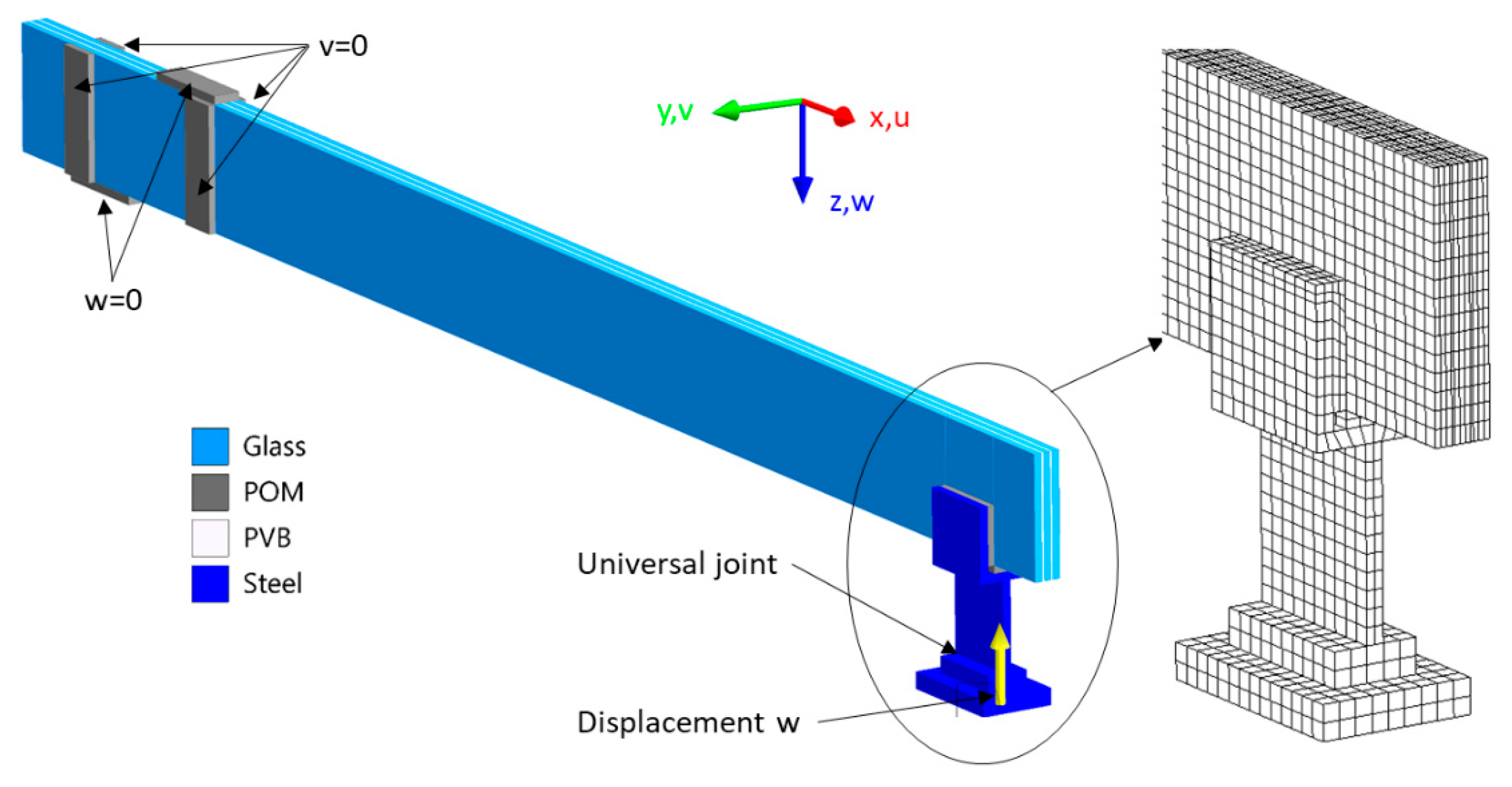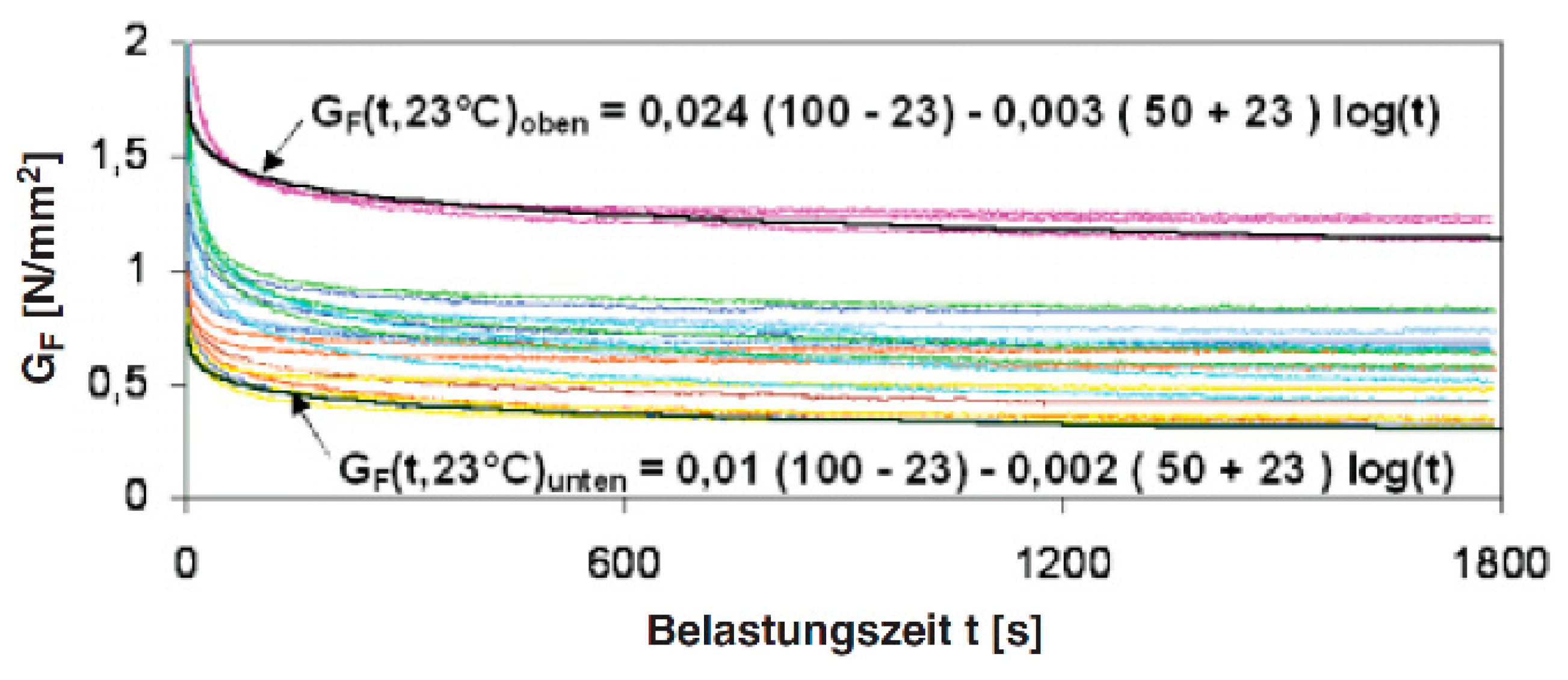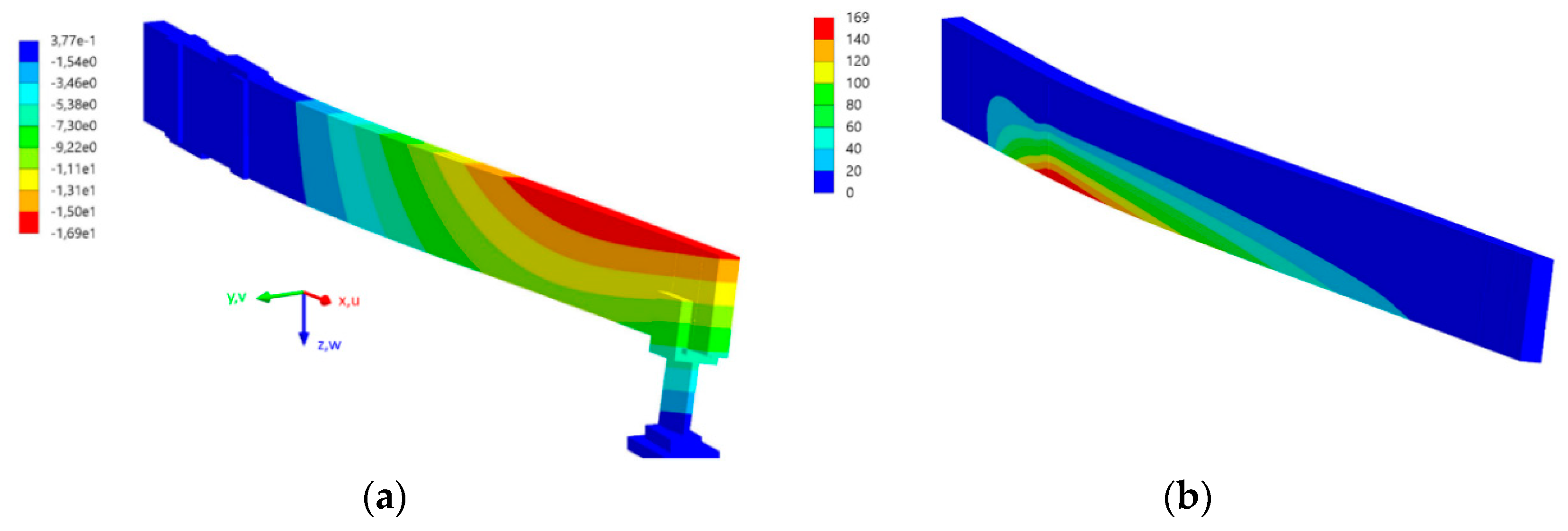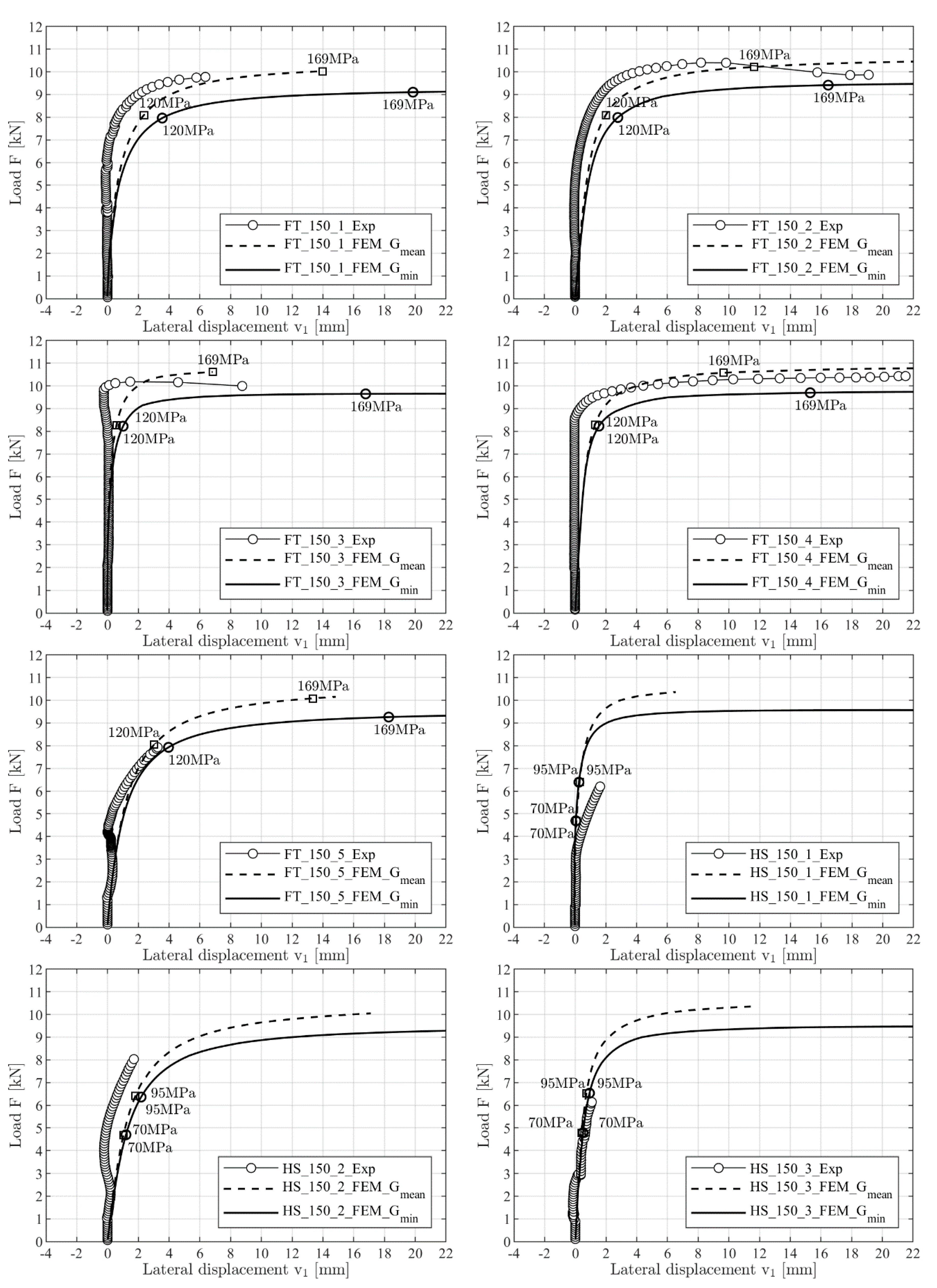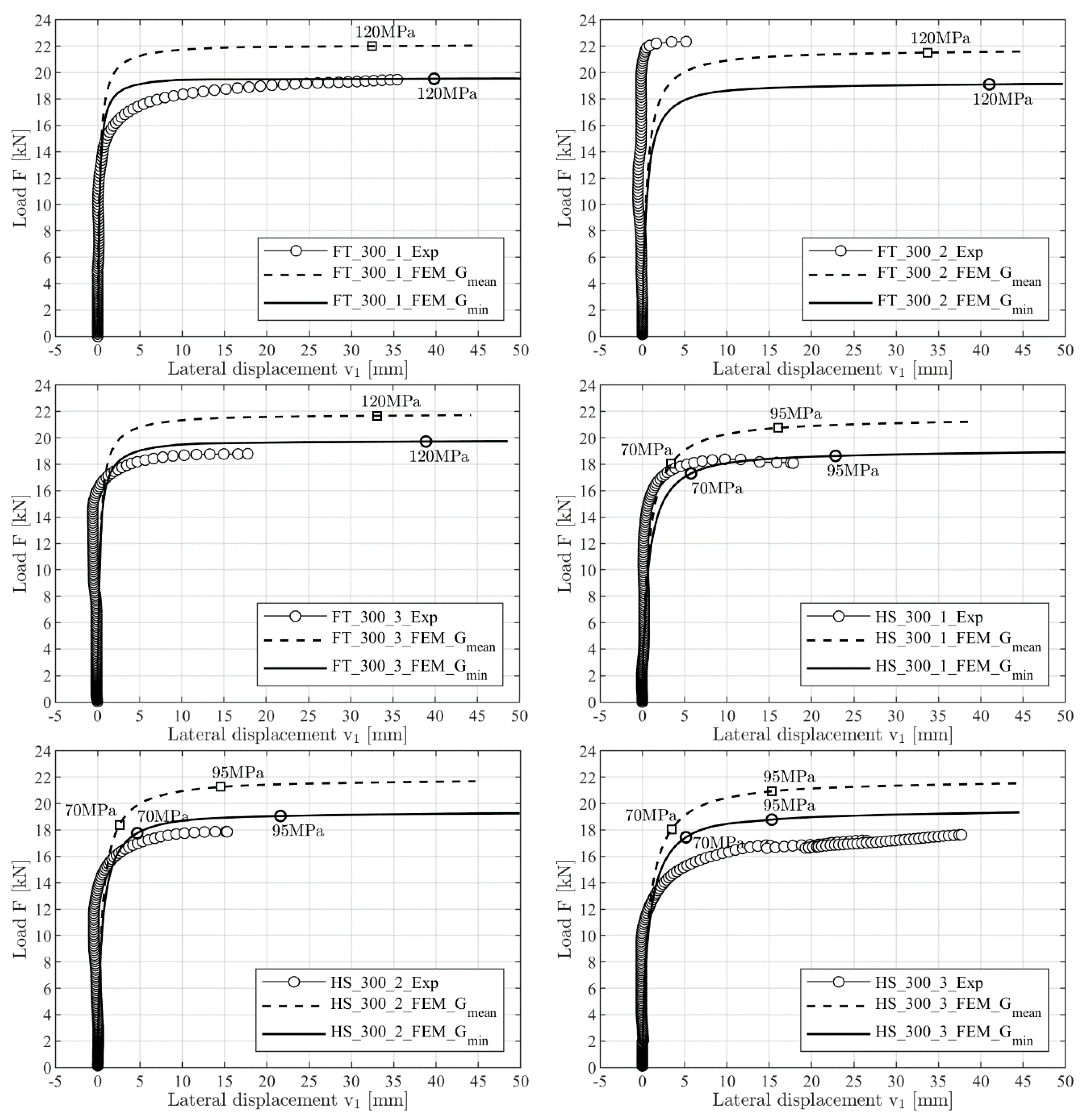1. Introduction
Due to its unique properties, glass has been used in buildings as a so-called “secondary structural glass component”, which means that it is used, for example, in windows or partition walls. In this case, the loads act normally on the glass elements, and the principal stresses result from pure bending. However, nowadays, glass is also used as a “primary structural component”, which means that glass elements are part of the global structure and the loads act in the glass plane. In such cases, the glass elements are typically used as beams or columns. Due to their high slenderness, stability issues must be taken into account.
Different investigations were made on the stability behavior of glass elements, like in [
1,
2,
3,
4,
5] for the buckling of columns under normal force or in [
6,
7,
8,
9,
10,
11,
12,
13,
14,
15] for lateral-torsional buckling (LTB) of beams under bending. The investigations were carried out experimentally as well as analytically and numerically. Single glass panels were taken into account as well as laminated glass beams, with and without lateral supports. Additional information on using glass as a shear-element can be found, for example, in [
16].
Especially in the case of lateral–torsional buckling problems, all the investigations mentioned above were made on single-span girders. However, a frequent application of glass beams in bending is the cantilever beam, e.g., as a canopy in front of an entrance. Unfortunately, there is little information available on this kind of usage, see [
17,
18].
By designing glass components, the selection of an appropriate glass type to ensure the safety requirements is an essential step. For “secondary structural glass components”, the requirements, depending on their usage, are already regulated in standards and will not be discussed any further (see [
19]). For “primary structural glass components”, higher requirements are usually placed on the safety level. Important aspects here are the glass strength, the robustness against local damage or local impacts, and the redundancy of the structure. These aspects will be further discussed (also compare [
19]).
In buildings, float-glass is the mainly used glass type for “secondary structural glass components”. By thermal treatment, float-glass can be further processed to fully tempered glass (FT) or heat strengthened glass (HS). Due to the thermal-induced stresses (compressive stresses at the surfaces), the thermally treated glass types can carry higher loads, which is a great advantage, especially for use as a “primary structural glass component”. Besides, thermally treated glass types are more resistant to local impacts, e.g., due to hail or vandalism. In contrast to float-glass, however, thermally treated glass is more expensive.
Single glass panels can be further assembled to “laminated safety glass” by connecting them with an interlayer (typically PVB-foil). If one of the glass panels breaks, the shards will stick to the foil. This reduces the risk of injury, and the intact glass panels can take over the load of the broken panel. This effect achieves a certain (local) redundancy of the glass component. The outer glass panels can also be regarded as protective layers of the inner panels. Due to the brittle nature of the material, the use of a single glass panel for “primary structural glass components” is not recommended. It should also be noted that the redundancy should not be limited to the glass component alone. Instead, the (global) redundancy of the whole construction should always be considered, which means, if a glass component fails, a safe load transfer via alternative load paths should be possible.
As mentioned above, the focus of the presented investigations is on the load-carrying behavior of cantilever beams made of glass, taking stability issues into account. Based on the previous explanations, the research goals and methods are defined as follows:
Research goals: Due to the widespread application of “primary structural glass components” used as cantilever beams, separate investigations on the lateral-torsional buckling behavior were carried out and presented in this paper. These investigations can be seen as a complement to the already performed work on this topic. The main goal of the presented research was to develop more economical design buckling curves for cantilever beams used as a canopy, taking into account their typical loading situations. Information for numerical simulations, like the shape and size of the imperfections, are additional outcomes.
Research strategy: In order to reach the defined goals, experiments on glass beams were carried out first. For this purpose, an adequate testing device was developed, and the real imperfections were measured. In a second step, the experiments were recalculated with a FE-software by implementing the measured imperfections and the real boundary conditions. Afterward, a parameter study on a wide range of cantilever beams was performed with the obtained FE-model. In order to avoid too large deformations, an additional serviceability criterion was considered. Special attention was also given to the boundary conditions to avoid stress concentrations, and therefore, to obtain the most realistic stresses. Based on the numerically obtained results, design buckling curves were developed. Because of the glass strength, the robustness against local impacts, and the redundancy when a single glass panel fails, only laminated safety glass consisting of thermally treated glass was used.
4. Parameter Study and Design Buckling Curves
Design buckling curves are a widely used and user-friendly method for considering the stability behavior of components. For other construction materials, such curves are already integrated into the different parts of the Eurocode (e.g., EN 1993-1-1 for LTB of steel girders). Using design buckling curves also for structural glass components was already proposed by other authors in earlier investigations. A summary can be found among others in [
8].
Following this approach, design buckling curves have been calibrated for the here investigated case of cantilever beams, which can be seen as an extension of the previously performed work on this topic. Therefore, the definitions used in the literature and Eurocode 3 were used as well:
For laminated safety glass, the critical moment
depends strongly on the shear modulus but can be calculated easily by using a FE-software and by performing a linear-buckling analysis (LBA). For practical use, the formulas based on a sandwich-theory appear to be more comfortable and faster. Such equations can be found among others in [
19]. In doing so, the time-dependent behavior of the PVB-foil can be taken into account by using the corresponding shear-modulus
, which results in a higher stiffness of the cross-section (and therefore lower slenderness) and a higher load-carrying capacity than in the case of a long-term behavior with
.
The here presented design buckling curves have been determined based on a parameter study by calibrating the imperfection factor
and the threshold value
. The parameters used for the parameter study are defined in
Table 7. All parameters were combined, and a total number of 512 calculations were carried out. The parameters used cover a broad range of systems (relative slenderness
from 0.4 to 2.8). Values not included in the used parameter range seemed to be unrealistic for practical usage.
The following criteria were defined to determine the ultimate load:
The maximum principal stress reaches the characteristic strength ,
the lateral deflection or the vertical deflection reaches a value of ,
the rotation reaches a value of .
The defined values were used to guarantee the serviceability for beams with large deformations. The used values are similar to those used in steel constructions for lateral-torsional buckling problems, see [
25,
26]. In most cases, the maximum principal stress was reached first. The geometric criteria were achieved in some cases only (especially for FT-glass with higher slenderness). In general, the influence of the geometric criteria was low; therefore, the results derived from excluding the geometric criteria will not be further disclosed.
The numerical model applied was similar to the model used for the recalculation of the experiments (see
Figure 3), but without modeling the load introduction (universal joint). The load was applied directly at the nodes of the top of the cross-section instead. As previously stated, the investigations have been carried out especially for cantilever beams, used, for example, as a canopy. Therefore, a constant bending moment proved unrealistic for practical use and was not considered.
The design buckling curves were fitted to the numerical results by using two different assumptions:
For both assumptions, the imperfection factor
was then increased until the design buckling curve reached the first numerical obtained result. A distinction was also made between the loading situation (single load F and distributed load q) and the glass type (FT and HS). The determined curves are shown in
Figure 9. For comparison, the recommended design buckling curve from [
8] with
and
was also plotted.
When using a threshold value of
(green lines), the developed curves appear to agree with the proposed curve given in [
8]. In one case, even identical coefficients were obtained (see
Figure 9b). When using threshold values
(red lines), the developed curves appear in being slightly more economical, especially when using FT-glass. Especially in the slenderness range of 0.2 to 0.5, other authors reported lower ultimate loads. Due to the chosen parameters (see
Table 7), only a few values were obtained in this range in the presented parameter study. However, as mentioned above, other parameters seemed to be unrealistic for practical usage. Other reasons for the different coefficients also arise maybe from the different loading situations and the somewhat different consideration of the imperfections. For a better comparison, the authors recommend [
8] for further reading.
5. Discussion and Conclusions
Experimental and numerical investigations on the lateral-torsional buckling behavior of cantilever beams were presented. First, an experimental device was developed. Such experiments are very demanding, a fact also reported by other authors, see [
4,
10]. Overall, the designed testing device worked well, and satisfying results were obtained.
In most cases, the recalculated load-deflection curves resulted in being in good agreement with the experimentally obtained curves. In some cases, more significant deviations were found, but these deviations could be explained technically (e.g., due to an offset between the single glass panels). The shear-modulus has a strong influence on the ultimate load level. Therefore, the lower bound given in [
11] was used and, compared to the tests, conservative results were obtained for nearly all cases. A more advanced calculation under consideration of a creep-law would probably give a better approximation; however, the values of the creep-law are unfortunately still unknown. In conclusion, the lower bound according to [
11] is recommended as shear-modulus for numerical simulations as the obtained values from other authors are tendentially higher and therefore less conservative (see the summaries given in [
22,
23] or the values given in [
27]).
Based on the measured imperfections, recommendations were given for numerical simulations. The recommended lateral imperfection of
from literature (e.g., [
8]) could be confirmed. Additionally, a value of
as unfavorable rotational imperfection at the free end of the cantilever beam should be taken into account.
The developed design buckling curves agree with the recommended curve in [
8] as a conservative approach. The curves obtained through this investigation are (slightly) more economical and are, therefore, recommended for the case of a cantilever beam under a single load or a distributed load, which is a frequent application of glass beams in bending. In addition, the presented design curves include a serviceability limit.


